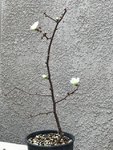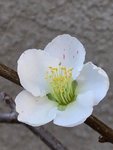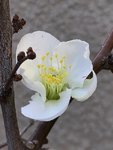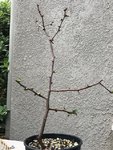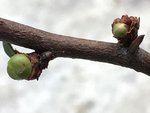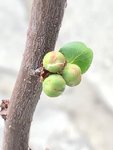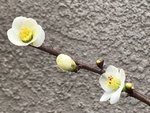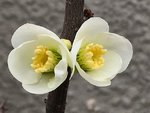You are using an out of date browser. It may not display this or other websites correctly.
You should upgrade or use an alternative browser.
You should upgrade or use an alternative browser.
Japanese Flowering Quince cuttings in training.
- Thread starter bonhe
- Start date
So pretty
bonhe
Masterpiece
Thanks Carol 83. When I look at it, it reminds me the Koi fish’ s lipsSo pretty
Thụ Thoại
bonhe
Masterpiece
bonhe
Masterpiece
bonhe
Masterpiece
bonhe
Masterpiece
エドガー
Shohin
When pruning a long branch of chaenomeles shorter, maybe down to 1 or 2 or 3 nodes, will they usually back-bud on older wood and/or ramify at the cut-site?
bonhe
Masterpiece
It will give new shoot at the nodes. I did not see it back bud at the old wood, but I see there is a flower bud emerged from the 4-5 years old wood. Hope this help.When pruning a long branch of chaenomeles shorter, maybe down to 1 or 2 or 3 nodes, will they usually back-bud on older wood and/or ramify at the cut-site?
Thụ Thoại
bonhe
Masterpiece
bonhe
Masterpiece
River's Edge
Masterpiece
Enjoy the blooms, my " Toyo Nishiki" is blooming nicely now as well as the Chojubai. I was wondering about your timing for " air layering quince and Ume. I note you usually do the quince in August in your region. Given the climate difference I would likely try June here in my zone 8a. Does that make sense to you? It would give approximately three months prior to frost activity and come well after flowering and leaf formation.This SMS is blooming now
View attachment 296071
View attachment 296072
View attachment 296073
View attachment 296074
Thụ Thoại
Leo in N E Illinois
The Professor
- Messages
- 11,339
- Reaction score
- 23,280
- USDA Zone
- 5b
Forgive me for asking @bonhe
This thread is now 492 posts in length. My memory fails me, and I am too lazy to go back and read through the whole thread again.
What is the full cultivar name that the abbreviation 'SMS' is referring too. And as you post other cultivars, could you use their full cultivar names at least once per every couple pages. I have been enjoying this thread very much, such lovely flowers. At some point I want to add some new cultivars of Chaenomeles to my collection and would like to know the cultivar names.
Thanks
Leo.
This thread is now 492 posts in length. My memory fails me, and I am too lazy to go back and read through the whole thread again.
What is the full cultivar name that the abbreviation 'SMS' is referring too. And as you post other cultivars, could you use their full cultivar names at least once per every couple pages. I have been enjoying this thread very much, such lovely flowers. At some point I want to add some new cultivars of Chaenomeles to my collection and would like to know the cultivar names.
Thanks
Leo.
エドガー
Shohin
Forgive me for asking @bonhe
This thread is now 492 posts in length. My memory fails me, and I am too lazy to go back and read through the whole thread again.
What is the full cultivar name that the abbreviation 'SMS' is referring too. And as you post other cultivars, could you use their full cultivar names at least once per every couple pages. I have been enjoying this thread very much, such lovely flowers. At some point I want to add some new cultivars of Chaenomeles to my collection and would like to know the cultivar names.
Thanks
Leo.
SMS = Sun Moon Stars, "My teacher told me that the sun is for the red flower, the moon is for the white flower, and the star is for the stripe one."
Japanese name = Nichi-Getsu-Sei
Iirc, he said it was a cultivar of a cultivar... from a special Toyo Nishiki... a true "3 color toyo nishiki" (ie: red flowers/petals on the same branch as a white+pink branch; which is rare for a regular Toyo Nishiki).
SMS may be different (I'm not too sure) than the already very unique "3 color toyo nishiki"... in that it seems his SMS regularly has multi-color petals.
I too enjoy this thread.. it actually made me pre-order some (my first ones)
bonhe
Masterpiece
Because of shorter growing season in your area, June is fine I think.I note you usually do the quince in August in your region. Given the climate difference I would likely try June here in my zone 8a. Does that make sense to you? It would give approximately three months prior to frost activity and come well after flowering and leaf formation.
Thụ Thoại
bonhe
Masterpiece
Thanks for suggestion Leo. I will remember to do thatForgive me for asking @bonhe
What is the full cultivar name that the abbreviation 'SMS' is referring too. And as you post other cultivars, could you use their full cultivar names at least once per every couple pages. I have been enjoying this thread very much, such lovely flowers. At some point I want to add some new cultivars of Chaenomeles to my collection and would like to know the cultivar names.
Thanks
Leo.
Thanks for helping me to answer Leo’ s question.SMS = Sun Moon Stars, "My teacher told me that the sun is for the red flower, the moon is for the white flower, and the star is for the stripe one."
Japanese name = Nichi-Getsu-Sei
Iirc, he said it was a cultivar of a cultivar... from a special Toyo Nishiki... a true "3 color toyo nishiki" (ie: red flowers/petals on the same branch as a white+pink branch; which is rare for a regular Toyo Nishiki).
SMS may be different (I'm not too sure) than the already very unique "3 color toyo nishiki"... in that it seems his SMS regularly has multi-color petals.
I too enjoy this thread.. it actually made me pre-order some (my first ones)
Yes, Toyo nishiki has 3 flower colors on the same tree: red, white and pink. SMS has red, white, white with red band, white with multiple red pots or stripes and red with white band. I think the Evergreen garden has this yow of quince but I don’t know if it will be exactly the same .
Thụ Thoại
Leo in N E Illinois
The Professor
- Messages
- 11,339
- Reaction score
- 23,280
- USDA Zone
- 5b
Thank you
River's Edge
Masterpiece
The " Toyo Nishiki" Improved strain from Evergreen has multicolour blooms that vary with the season and condition of the plant! By this I mean that each year there appear to be subtle differences in display! Also the flowers seem to have more intensity as the plants become more established. I believe the multicolour branching is a result of grafting and the colours are restricted to the grafted branch. White on the white branch, pink on the pink, red and white on the red and white branch. At least that has been my experience and observations with the strain so far! Hope this information helps.Thanks for suggestion Leo. I will remember to do that
Thanks for helping me to answer Leo’ s question.
Yes, Toyo nishiki has 3 flower colors on the same tree: red, white and pink. SMS has red, white, white with red band, white with multiple red pots or stripes and red with white band. I think the Evergreen garden has this yow of quince but I don’t know if it will be exactly the same .
Thụ Thoại
エドガー
Shohin
The " Toyo Nishiki" Improved strain from Evergreen has multicolour blooms that vary with the season and condition of the plant! By this I mean that each year there appear to be subtle differences in display! Also the flowers seem to have more intensity as the plants become more established. I believe the multicolour branching is a result of grafting and the colours are restricted to the grafted branch. White on the white branch, pink on the pink, red and white on the red and white branch. At least that has been my experience and observations with the strain so far! Hope this information helps.
Oh, I see! So you already have the "Improved" version from Brent? That's the one I ordered a month or so ago (but not avail until summer or fall).
Please post pics of it whenever you can!
In your opinion, do you think it's similar to Bonhe's SMS strain??
River's Edge
Masterpiece
As I understand it Brent is very careful to sell only after he is sure the product is healthy, the supply is limited each year and he is careful to not rush them out the door too soon. My stock was obtained some years ago so I cannot speak for the latest material. It is not unusual to be on a waiting list for some of Brents material. I am very fond of the ones I have. The color has improved as the plants size and health has improved. Gradually I am understanding their needs a bit better over time.Oh, I see! So you already have the "Improved" version from Brent? That's the one I ordered a month or so ago (but not avail until summer or fall).
Please post pics of it whenever you can!
In your opinion, do you think it's similar to Bonhe's SMS strain??
From the pictures , I believe Bonhe's to be a bit different and more striking in color. Sharper contrast in the white and red portions. This may be due to husbandry , selective propagation and or climate. It would be easier to judge were the plants side by side of course.
Similar threads
- Replies
- 2
- Views
- 1K
- Replies
- 12
- Views
- 2K




